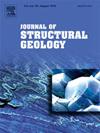The influence of columnar joints and joint pattern on near-surface normal faulting: An analog modeling approach
IF 2.6
2区 地球科学
Q2 GEOSCIENCES, MULTIDISCIPLINARY
引用次数: 0
Abstract
Normal faults at mid-ocean ridges develop massively dilatant structures close to the surface. Situated close to plate boundaries, these faults form in volcanic rocks such as basalt, which are characterized by columnar joints. These joints cause an orthotropic mechanical behavior of the rock mass, characterized by contrasting strong intact rock and weak, low-cohesion joint networks. To date, the influence of these columnar joints on the geometry and evolution of near-surface normal faults remains poorly understood. We present an analog modeling approach utilizing new analog modeling materials: i) layers of desiccated cornstarch forming drying cracks and resembling layered columnar joints in basaltic lava flows, and ii) systematically stacked blocks representing different joint patterns with varying block overlaps above vertical cooling joints. The geometric scaling of these models allows to assess the near-surface structures in the upper 50–150 m. The models reveal that fault formation is dominated by opening mode displacement reactivating the pre-existing joints and the style of deformation changes with progressive localization of the main fault. Observed structural features such as a tilted block bound between a main and antithetic fault, relay ramps, vertical mass transfer, and open cavities transfer well to the natural prototypes. Our newly developed experiments form a basis for future studies exploring fault processes in jointed rock masses.
柱状节理及其节理形态对近地表正断层的影响:一种模拟模拟方法
洋中脊的正断层在靠近地表的地方发育出大量膨胀的构造。这些断层靠近板块边界,形成于火山岩中,如玄武岩,其特征是柱状节理。这些节理导致了岩体的正交各向异性力学行为,其特征是对比强烈的完整岩石和弱的低黏聚节理网络。迄今为止,这些柱状节理对近地表正断层的几何形状和演化的影响仍然知之甚少。我们提出了一种利用新的模拟建模材料的模拟建模方法:i)干燥的玉米淀粉层形成干燥裂缝,类似于玄武岩熔岩流中的层状柱状节理;ii)系统地堆叠块,代表不同的节理模式,在垂直冷却节理上方有不同的块重叠。这些模型的几何尺度可以评估50-150米以上的近地表结构。模型表明,断层的形成以开启型位移为主,激活了原有的节理,变形形式随着主断层的逐步局部化而改变。观察到的结构特征,如主断层和反断层之间的倾斜块体边界、继电器斜坡、垂直传质和开洞,都可以很好地转移到自然原型中。我们新开发的实验为进一步研究节理岩体中的断层过程奠定了基础。
本文章由计算机程序翻译,如有差异,请以英文原文为准。
求助全文
约1分钟内获得全文
求助全文
来源期刊

Journal of Structural Geology
地学-地球科学综合
CiteScore
6.00
自引率
19.40%
发文量
192
审稿时长
15.7 weeks
期刊介绍:
The Journal of Structural Geology publishes process-oriented investigations about structural geology using appropriate combinations of analog and digital field data, seismic reflection data, satellite-derived data, geometric analysis, kinematic analysis, laboratory experiments, computer visualizations, and analogue or numerical modelling on all scales. Contributions are encouraged to draw perspectives from rheology, rock mechanics, geophysics,metamorphism, sedimentology, petroleum geology, economic geology, geodynamics, planetary geology, tectonics and neotectonics to provide a more powerful understanding of deformation processes and systems. Given the visual nature of the discipline, supplementary materials that portray the data and analysis in 3-D or quasi 3-D manners, including the use of videos, and/or graphical abstracts can significantly strengthen the impact of contributions.
 求助内容:
求助内容: 应助结果提醒方式:
应助结果提醒方式:


